Abstract
Territories throughout different continents have a wide variety of natural and cultural resources, defined by the dynamics of spatiality, temporality, and functionality that have been generated by the human groups settled in these spaces. These resources have become an object of study of great interest since they constitute the initial sources for the definition of the tourism potential of destinations, as well as contributing to the generation of new tourism activities and modalities for those already consolidated. Although these resources were initially used as objects of exploitation, with the passage of time the dynamics have changed to the use of these resources, focusing on the foundation of the pillars of sustainability, a condition that implies practices of environmental valuation in situ, the recognition of the cultural heritage of the territories and the valuation of the interaction between culture–nature–human beings. The objective of this research is to identify the existing scientific production in which the relationship between the tourist exploitation of natural and cultural resources and regional development is explored. Bibliometric analysis based on the guidelines of the PRISMA method was used. The international databases considered were Web of Science and Scopus. The analysis was complemented with an overlap analysis to establish the relationship of information between the WoS and Scopus databases. A total of 507 documents on the subject were identified, which provided a preliminary X-ray that will allow future research work to be focused on this line of re-search. The results allowed us to observe that there is little literature on the relationship between the use of natural and cultural resources for tourism and the regional development of the territory, both from an economic and social point of view.
1. Introduction
The relationship between the process of exploiting resources, both natural and cultural (tangible or intangible) by tourism activity, and the development of territories, is configured as a constant dynamic between human beings and their environment [1,2,3,4,5,6]. In this regard, the resources of a territory “are part of a network of great value and wealth, which must be promoted and marketed in a sustainable way, with the aim of improving the socioeconomic development of local populations in destinations and the conservation of resources” [7]. On the other hand, the World Tourism Organization [8] states that tourism activity can favor local development or that of a geographical area if it is configured as “an integral part of balanced sustainable development, providing benefits to all tourism stakeholders of a destination”.
Therefore, through the use of knowledge related to the resources, both renewable and non-renewable of each territory, human beings carry out an economic transformation process of those resources through tourism activity. The first group includes natural and cultural resources, which although they may not always be of exceptional value as proposed by UNESCO, it is recognized that all territories have the capacity to attract the attention of other people, thus leading to tourist flows, as tourism can enhance spaces or objects that are not of interest for other activities [9]. In this context, Myga–Piątek [10] states that all natural and cultural elements, which each territory harbors, are established as basic resources for the development of tourism activity, since they provide scenic values and fulfill recreational, emotional, cognitive, and operational functions [11]. It should be pointed out that for a person to engage in some type of tourism, there must be some motivation for the visit (resources), which serves as an attraction for the tourist and in this way, the recreational activities to be carried out in the destination can be taken full advantage of.
There are many and varied resources with the potential for tourism exploitation [12]. They converge in building an environment that provides the elements and materials from which the shaping force of culture creates the cultural landscape [13,14]. Within the natural resources, all the natural heritage and natural processes that make it up are considered, thus integrating a wide diversity of ecosystems and life zones, while cultural resources focus on the knowledge of the culture of other spaces, which has become one of the first reasons to generate tourism trips in the world. Along with it, the cultural heritage of societies is built, encompassing a wide variety of elements ranging from tangible to intangible. All these resources have become the current basis for enhancing the image and brand of destinations [15].
The use of resources should be focused on achieving local development, which enables the creation of economic alternatives (business activity), social security, fighting poverty, and a healthy lifestyle and sustainable development [2,5,9,16,17,18,19,20,21,22]. In addition, this has a parallel effect of protecting the natural and cultural heritage. In this context, the local population becomes the key actor for its management [23] enabling good governance of tourist sites and the emergence or repositioning of economically depressed territories [24].
Undeniably, tourism has been proposed as a sustainable economic alternative for spaces of diverse nature [25]. UNESCO has also recognized the capacity of natural and cultural heritage as a resource for sustainable territorial development. In this regard, the UNWTO encourages linking all forms of tourism with sustainable development, with the aim of achieving sustainable tourism, which is a trend seen as one of world’s leading travel practices [26,27]. This is due to the fact that tourists are increasingly aware of the impact that their visit can cause both environmentally [28] and culturally [29].
Based on this context, alternative forms of tourism have emerged as a mechanism of use, which are established as an offer opposed to mass tourism, such as creative tourism, ecotourism, agro-tourism, community tourism, and rural tourism, among others [23,30,31,32,33,34,35]. On the basis of these forms of exploitation, the aim is to achieve sustainable tourism as an umbrella for the management of areas in which there is not only one single perspective, but which is as inclusive as possible in order to achieve the conservation of natural resources and cultures, without causing their degradation, thus allowing the continuity of their tourist operation over time [36].
In this context, tourism—the use of natural and cultural resources—regional development, the aim is to identify the existing scientific production that explores the relationship between tourism exploitation of natural and cultural resources and regional development. It was identified and analyzed using bibliometric analysis following the guidelines of the PRISMA method. The databases considered were Web of Science and Scopus. This literature review was conducted in accordance with Page et al. [37] that “systematic reviews are useful in many critical ways, as they can provide a synthesis of the state of knowledge in a given area, from which future research priorities can be identified, questions addressed that otherwise cannot be answered by individual studies and problems in primary research that should be corrected in future studies be identified …” (p. 1). This synthesis of the state of knowledge in a specific area is of interest to researchers on the subject. On the other hand, there is no bibliometric study on the subject. In fact, there are studies that cover specific areas on the use of natural and cultural resources by tourism and their relationships with regional development, such as the study by Álvarez–García et al. [38] on the relationship between the use of cultural heritage by tourism and regional development (WoS and Scopus database) and the study by del Río–Rama et al. [39], considering island tourism (Scopus) or the study by Pimienta et al. [40], in which they study the relationship in a creative tourism environment. Other bibliometric studies are Herrera–Franco et al. [41,42] in geotourism and geoparks, and Zeng et al. [43] in mountain tourism.
This document is structured in 4 sections. The introduction contextualizes the study area, sets out the objective, and justifies the novelty. Section 2 presents the search criteria for scientific documentation, the PRISMA statement and the search equations. Section 3 collects the results obtained and the last section includes the conclusions derived from the analyses carried out together with the limitations of the research conducted.
2. Materials and Methods
To meet the stated objective, a bibliometric analysis using mathematics, applied statistics, and other research ideas was developed [44]. The aim was to achieve a detailed review of a large amount of information, both in general and specific terms, by means of various tools [45,46,47]. This contributes to the purpose of identifying and characterizing the processes of exploitation of natural and cultural resources linked to tourism.
The process of constructing the study was based on a systematic and thorough search for the documentary units that will articulate the database for the analysis of the thematic approach under study [48,49]. In this way, the reliability and validity of data collection will be closely related to the protocol applied, thereby increasing the precision of the analysis [50,51]. Among the criteria to be considered are the database to be used, quality of metadata, time coverage, and coverage of documentary units, among other elements that could improve the quality of the reviews by allowing the protocol to be transparent, consistent, and reproducible [52,53].
2.1. Search Criteria and Identification of Sources
The systematic search protocol is applied to the international and multidisciplinary databases Scopus from Elsevier and Web of Science (WoS) provided by Clarivate Analytics integrated into the ISI Web of Knowledge. These databases have four key characteristics that influenced the decision to use them in this research: (a) access and download to a wide variety of metadata, a condition that facilitates the identification and characterization of documentary units; (b) coverage of a wide variety of areas of science [54]; (c) relative quality indices that are SJR—SCImago Journal Rank from Scopus and JCR—Journal Citation Reports from WoS, an element that supports the quality of the information provided by the databases [55]; and (d) broad time coverage [56].
Table 1 shows the criteria and search equations used in both databases.

Table 1.
Details of the search criteria.
2.2. Method or Statement PRISMA
The use of the PRISMA method in this research allowed a systematic review to be conducted following quality parameters “by describing why the review was conducted, what was done and what was found” [37] (p. 2). The process consisted of three phases: identification of studies, screening, and inclusion of studies. In the first phase, to identify the documents, the search was carried out by using query terms and search operators. The construction of the advanced search equation is a decisive element for the entire process because the combination of elements should make it possible to describe the entire thematic approach, in order to achieve the broadest possible coverage and capture the largest possible number of documents [57,58,59] (Table 2). From the application of the search equation, 593 articles were identified in Scopus and 262 in WoS, consolidating 855 initial documents.

Table 2.
Search equations by database.
In the second phase (document screening), the exclusion criteria corresponding to the refinement of the metadata were applied: elimination of junk codes, blank spaces within the general database, elimination of duplicate documents, and all those that did not have identifiable bibliometrics were also discarded, as well as those that were not related to the thematic approach based on a bibliographic review of the title, abstract, and keywords [57]. Finally, the articles participating in the analysis were defined with a total of 553 (Figure 1).
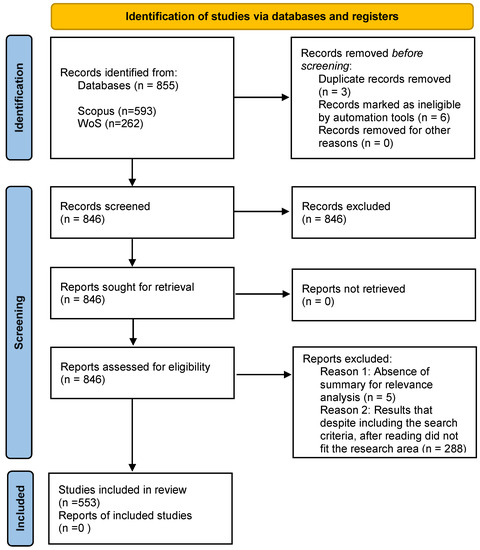
Figure 1.
PRISMA method procedure that details the steps in the identification and selection of documentary units. Note: PRISMA 2020 flowchart. The new design has been adapted from the flowcharts proposed by Boers [60], Mayo–Wilson et al. [61], and Stovold et al. [62].
2.3. Data Extraction
Once the work base was consolidated, the information from the general set of articles was downloaded from both the Scopus and WoS databases. The information was processed in *.ris format, thus facilitating the identification of all the variables to be analyzed by the indicators of the bibliometric study. For the evaluative analysis, Microsoft Office Excel software was applied, and for the relational analysis or scientific mapping, the bibliometric analysis software VOSviewer was used [63,64,65,66,67]. Bibliographic reference management was carried out using the Mendeley program.
2.4. Data Analysis
Three types of analysis or approaches were followed for the data analysis. First, a study of the overlap of production between the databases was carried out, with the purpose of establishing the singularity of the information [38,49], as well as the overlap of data. Three mathematical calculations were used (Table 3).

Table 3.
Overlapping analysis.
An evaluative analysis was then carried out by applying three types of indicators [72,73].
(1) Quantity indicators, i.e., they establish production and productivity measures which analyze the number of articles based on the variables authors/years/journals/countries/institutions/collaborations [74];
(2) Performance indicators, which correspond to measures that capture the impact and record of use achieved by the production, based on variables such as total citations per author/journal/country/year [75];
(3) Structural indicators, which determine the connections between the previous types, based on variables such as journals/authors/research areas [72,76,77].
The selection of these indicators corresponds to the most accepted types of analysis within the bibliometric field, and they provide accurate and reliable results [78,79,80,81].
The third type of analysis, which complements the previous ones by performing a deeper analysis, is network mapping of scientific literature with VOSviewer. Through this mapping, social, and intellectual relationships and interactions are visualized [49], using several variables such as citations, words, authors, and bibliographic coupling [47,82,83]. Co-occurrence analysis is established as a very useful method for dimensioning research fields, since it graphically provides an overview of the links achieved to date [39,84].
3. Results
3.1. Overlap of Databases
The linear correlation coefficient of 0.86 shows a high correlation between Scopus and WoS. The database to be analyzed is composed of 553 articles, of which 506 are single (373 in Scopus, which represent 87% of the total, and 133 in WoS, which represent 74%) and 47 are present in both databases. The Meyer Index (MI), which determines the singularity of articles by database, is 0.94 for Scopus, and WoS reaches MI of 0.87. A similar distribution is shown for the singularity by journals with MI = 0.90 for Scopus and MI = 0.79 in WoS (Table 4).

Table 4.
Singularity of the databases.
Through the % traditional overlapping (TO) between Scopus and WoS, a similarity of 9.29% between the bases is observed, showing a disparity of 90.71% between the two. Relative overlapping (RO), which determines the percentage of coverage that Scopus has in relation to WoS and vice versa [69], is 12.60% (Scopus is overlapped by WoS), and 26.11% (WoS is overlapped by Scopus). The data indicate that Scopus has a greater overlap over the other database, a situation that may be a consequence of the indexing time period of the databases, since not all the resources that are published are common between them.
3.2. Productivity per Year
As already mentioned, 506 single documents published over 39 years are identified and two phases are observed. The first phase, which corresponds to the so-called precursors, is made up of 86 articles in 24 years and the second phase shows exponential growth, with 421 articles in 15 years (Figure 2). Since 2007, an increase in production can be seen, with the exception of the years 2011 and 2020, in which a slight reduction is shown. It should be noted that 53% of the total production has been developed in the last seven years. This trend is maintained in both databases, 53% of Scopus production and 59% of WoS is generated in that period. This trend highlights the exponential growth (phase 2) that this academic field is experiencing (R = 0.93), as established by the Law of Price [85].
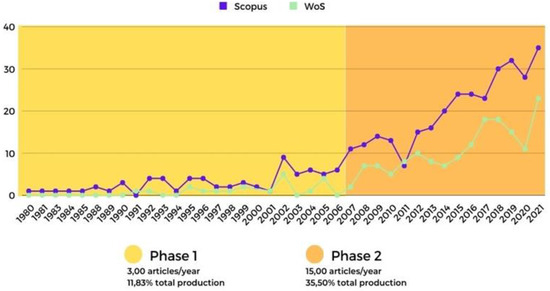
Figure 2.
Trend of publications Scopus and WoS. Source: Authors’ own data.
The first document in relation to this field is entitled Esp ace rural et domination: le tourisme dans les ardennes belges de Mormont [86].
2021 was the most productive year with 49 documents indexed, 35 in Scopus, and 23 in WoS, with 9 duplicated in both bases. The increase in production in the last year of study demonstrates the interest of researchers in this field of study (use of natural and cultural resources by tourism for regional development).
3.3. Citations
The number of citations identified is 4055 in 373 Scopus articles, and 1702 citations in 133 WoS articles. A ratio of 10.87 and 9.46 citations/articles was determined, respectively. The year with the highest production is 2017, with 299 citations in Scopus and 195 in WoS. In addition, Figure 3 shows that 64% of Scopus articles and 56% of WoS have reached between 1 and 25 citations. Among the factors that may affect this condition are the length of the document, the number of citations used, the publication year, impact factor of the journal, and the inter-institutional collaboration of authors [87,88,89].
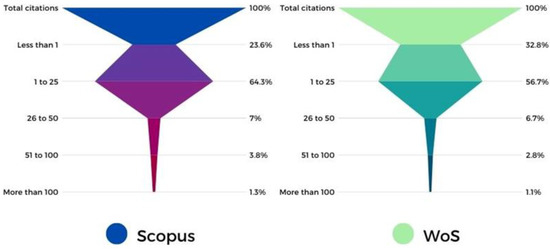
Figure 3.
Distribution of citations by articles. Source: Authors’ own data.
Among the most cited articles (Table 5), two opposing trends were identified. On the one hand, the leader of the ranking with 230 citations refers to the relationships that can affect the tourist use of heritage cities based on the analysis of a vicious circle [90]. The second document, indexed in both databases, with 156 citations in WoS and 141 in Scopus, points to the conceptualization of rural tourism as a stimulus for the generation of new leisure activities, recreation, and production of new tourist experiences [91].

Table 5.
Ranking of the most cited articles.
3.4. Authors
The database identified 1.268 signatory authors from countries such as China (191), Russia (123), South Korea (82), Portugal (72), the United States (71), Spain (68), and Mexico (57). It is observed that this area of knowledge arouses interest worldwide; the documents had signatories from all continents (Figure 4).
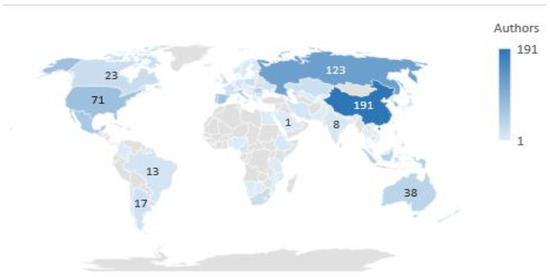
Figure 4.
Distribution of authors by country. Source: Authors’ own data.
A total of 62 authors are identified as the most productive. The collaboration networks between these authors do not generate significant work clusters, representing endogenous work relationships within this area of knowledge. This is corroborated by obtaining a production index per author of 1.05 articles. Considering the total productivity per author, the authors can be classified into four groups following the classification by Crane [96]. In the analysis carried out, only two types of authors are identified: applicants (production of 2 to 4 articles) and bystanders (single article production) (Figure 5). The distribution is very similar in both databases.
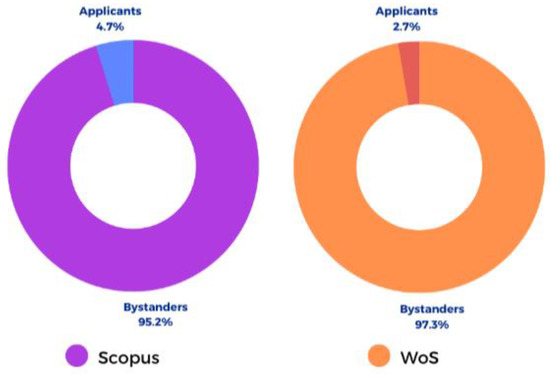
Figure 5.
Authors classification Crane system. Source: Authors’ own data.
Between the two databases, only 3 authors with more than three articles can be seen, of which Remoaldo and Ruban are recurrent between both bases (Table 6).

Table 6.
Ranking of the most productive authors.
In total, 73% of the works were carried out collaboratively, with a distribution of 79% of national authors and 21% of international authors. This trend supports what was stated by Berelson [97], i.e., the area of knowledge is reaching a greater maturity. Within the articles signed by authors from the same country, 60% belong to the same institution and 40% have affiliations from different institutions; the articles produced by authors from different countries are distributed in 96% of affiliations of different institutions and 4% with equal affiliations (Figure 6).

Figure 6.
Distribution of collaboration in the knowledge area. Source: Authors’ own data.
The authorship index is 2.8 authors per article for Scopus and 2.5 for WoS. Figure 7 shows that between the two databases, 149 articles are signed by 2 authors, followed by 99 articles signed by 3 authors.
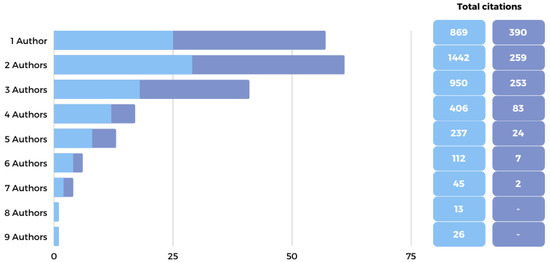
Figure 7.
Distribution of articles and citations by number of authors in Scopus and WoS. Source: Authors’ own data.
The co-citation analysis of authors showed that 25,847 authors were co-cited. A total of 16 of these authors met the threshold of 30 or more citations, establishing five work clusters. The first cluster was led by Hall, who developed 12 links with 99 citations, followed by Liu, leader of the blue group with 13 links that generated 61 citations, and finally Scott, with 9 links and 42 citations within the green group (Figure 8).
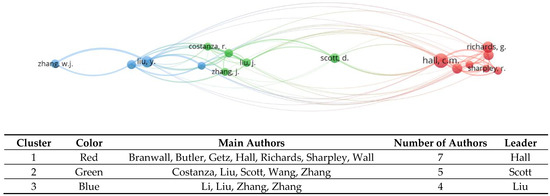
Figure 8.
Author co-citation analysis (ACA) in Scopus. Source: Authors’ own data.
3.5. Productivity by Type of Institutions and Country
Productivity by country of affiliation (Table 7) identified China as the country with the highest production, with 91 authors, 187 authorships, and 79 centers. It was followed by Russia with 123 authors, 113 authorships, and 52 centers. Regarding the accumulation of citations by country, the leader in Scopus was Australia with 1210 citations, followed by the United States (1178), and in WoS, the United Kingdom led with 834 citations, followed by the United States (665).

Table 7.
Number of centers, authors, and authorships by their country of affiliation.
Figure 9 shows the countries with the highest production of articles, China (81), Russia (56), the United States (44), Spain (27), and Portugal (21).

Figure 9.
Distribution of articles by country in Scopus and WoS. Source: Authors’ own data.
Table 8 shows the ranking of the most productive institutions. This is led by the Chinese Academy of Sciences (China), which accumulates 23 authors and 25 affiliations in both databases, followed by the Universidade dos Açores (Portugal), which registers 13 authors and 13 authorships.

Table 8.
Most productive institutions with authors and authorships.
Productivity by institution registers 644 affiliation centers, with universities being the ones that concentrate the largest share of affiliations with 78% (505), followed by institutes with 12% (78).
3.6. Journals
The total number of articles have been published in 340 journals and, excluding duplicates in both databases, 285 were identified. A total of 39% of the journals published only one article on this subject. The Dispersion Index is 1.90 articles/journals. Figure 10 shows the 4 main thematic areas to which the journals indexed in WoS are associated, with Environmental Sciences and Ecology leading with 35 articles, as well as Figure 11, which shows the Scopus areas, with the main area being Social Sciences with 125 articles.
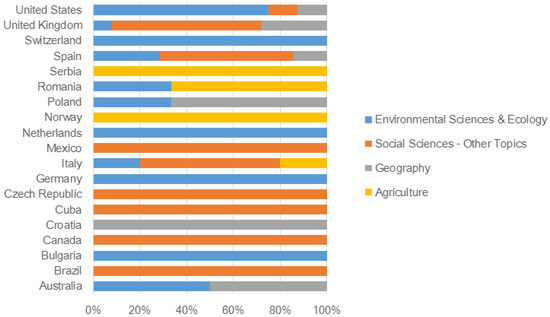
Figure 10.
Distribution of journals by area and country of publication in WoS. Source: Authors’ own data.

Figure 11.
Distribution of journals by area and country of publication in Scopus. Source: Authors’ own data.
A total of 26% of the journals were indexed in quartile 1, 20% in quartile 2, 21% in quartile 3, and 15% in quartile 4. Indexing was not available for 18% of the journals due to two factors: (a) because the journal left the database, or (b) because it was added to the database during this year.
3.7. Keywords
In relation to the keywords used in this type of study (Figure 12), sustainable development, tourism development, regional planning, economic development, and ecotourism stood out. These terms had a greater presence between 2010 to 2012. Among the most contemporary terms that arose from 2014 onwards, natural resources, cultural heritage, sustainability, and stakeholders were identified, showing how the process of sustainable development has been linked to the protection, conservation, and safeguarding of natural and cultural resources.
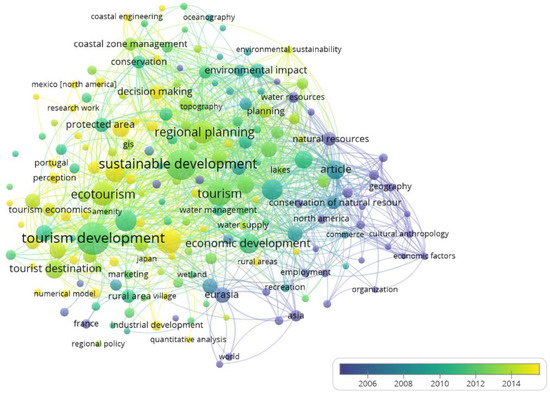
Figure 12.
Key words. Source: Authors’ own data.
4. Conclusions
The joint integrated database with 507 articles, which allowed us to fulfill the objective proposed in this research, shows that there is little research in relation to this subject, with scientific production developed over 39 years. It was identified that 60% of the studies in both databases obtained between 1 and 25 citations, in addition to the fact that 96% of the authors were transient, and only one author with moderate production was identified in Scopus with 6 studies. The average collaboration was 2.65 authors per document in the general context of the approach, with a predominance of collaboration between authors from the same country, but generally affiliated to different institutions. Production by country was concentrated in China, Russia, South Korea, Portugal, and the United States. This aspect is corroborated by the scientific mapping, which showed that there were no consolidated collaboration relationships, all of which were endogenous at the moment. Within the ACA analysis, three clusters of work were identified, which had a reduced number of authors, as well as a reduced number of citations. One thing that stood out was that the leading authors of each of the co-citation clusters addressed tourism issues, but did not present the production linked to the thematic approach under study. The resources in which these types of articles were published were linked to environmental sciences, social sciences, earth sciences, and biological sciences. The journal with the highest number of publications was Sustainability with 20 articles, while Annals of Tourism Research accumulated the highest number of citations with 261 in Scopus and Tourism Geographies in WoS with 246.
The scientific mapping obtained in this research showed that there is little literature on the relationship between the use of natural and cultural resources by tourism and the regional development of the territory, both from an economic and social point of view. Therefore, it is clear that there is a need for researchers to study this subject more in depth on an ongoing basis, and it was observed that researchers in this area, following Crane’s classification [96] were transient with only a single publication. Therefore, there were no consolidated groups of researchers on the subject, nor were there any large producers.
The need for research in this area is reinforced if we consider that tourism, as mentioned by the World Tourism Organization, is an activity that is showing sustained growth worldwide and that there is a strong link between its growth and the use of its natural and cultural resources. Tourism is also one of the main alternatives for territorial economic development in many territories.
This subject must be approached from different social disciplines such as economics, sociology, psychology, anthropology, geography, and political science, among others, in order to know and understand this phenomenon and produce new knowledge. Among other approaches, it is important to investigate the role of the different types of tourism developed based on the use of natural and cultural resources in regional development.
Like all research and taking into account the technique used, bibliometric analysis has several limitations. The first one refers to the use of a certain search equation in which terms are included that may not be explicitly included in the search fields of the document considered by the database search engine, as well as not including all possible terms. Another limitation is that the two main international databases (English language) are used; however, there are many others (SciELO-Scientific Electronic Library Online, ProQuest, EBSCO, etc.). Therefore, future research could expand the databases used. Finally, the approach followed is quantitative in nature, which makes it possible to obtain an X-ray of the current state of the publications on the subject (authors, number of publications, etc.), without delving into their content. Therefore, this research could be extended through an analysis of the content of the documents, allowing the results of existing studies in the scientific literature on a topic to be compiled, which would allow identifying the conceptual structure of the topic.
Author Contributions
Conceptualization, C.P.M.-E., M.d.l.C.d.R.-R., J.Á.-G. and A.C.F.-M.; formal analysis, C.P.M.-E., M.d.l.C.d.R.-R., J.Á.-G. and A.C.F.-M.; investigation, C.P.M.-E., M.d.l.C.d.R.-R., J.Á.-G. and A.C.F.-M.; methodology, C.P.M.-E., M.d.l.C.d.R.-R., J.Á.-G. and A.C.F.-M.; writing—original draft, C.P.M.-E., M.d.l.C.d.R.-R., J.Á.-G. and A.C.F.-M.; writing—review and editing, C.P.M.-E., M.d.l.C.d.R.-R., J.Á.-G. and A.C.F.-M. All authors have read and agreed to the published version of the manuscript.
Funding
This publication has been funded by the Consejería de Economía, Ciencia y Agenda Digital de la Junta de Extremadura, and by the European Regional Development Fund of the European Union through the reference grant GR21161.
Institutional Review Board Statement
Not applicable.
Informed Consent Statement
Not applicable.
Data Availability Statement
Not applicable.
Conflicts of Interest
The authors declare no conflict of interest.
References
- Ryan, C.; Zhang, C.Z.; Deng, Z. The impacts of tourism at a UNESCO heritage site in China—a need for a meta-narrative? The case of the Kaiping Diaolou. J. Sustain. Tour 2011, 19, 747–765. [Google Scholar]
- Vargas-Hernández, J.G. World Journal of Entrepreneurship, Management and Sustainable Development. World J. Entrep. Manag. Sustain. Develop. 2012, 8, 146–161. [Google Scholar]
- Li, Y.; Lau, C.; Su, P. Heritage tourism stakeholder conflict: A case of a world heritage site in China. J. Tour. Cult. Chang. 2020, 18, 267–287. [Google Scholar]
- Panzera, E.; De Graaff, T.; De Groot, H.L. European cultural heritage and tourism flows: The magnetic role of superstar world heritage sites. Pap. Reg. Sci. 2021, 100, 101–122. [Google Scholar]
- Maruyama, N.U.; Woosnam, K.M. Representation of “mill girls” at a UNESCO World Heritage Site in Gunma, Japan. J. Sustain. Tour. 2021, 29, 277–294. [Google Scholar] [CrossRef]
- Zhen, R.C.; Chao, Y.F.; Qian, Z.; Fu, L.C. Joint development of cultural heritage protection and tourism: The case of Mount Lushan cultural landscape heritage site. Herit. Sci. 2021, 9, 86. [Google Scholar]
- Castellanos Verdugo, M.; Orgaz Agüera, F. Potencialidades ecoturísticas de la República Dominicana. Turydes Rev. De Tur. Y Desarro. Local 2013, 6, 1–15. [Google Scholar]
- World Tourism Organization. Tendencias de los Mercados Turísticos: Panorama Mundial y Actualidad del Turismo; World Tourism Organization: Madrid, Spain, 2003. [Google Scholar]
- Angelkova, T.; Koteski, C.; Jakovlev, Z.; Mitrevska, E. Sustainability and Competitiveness of Tourism. Procedia Soc. Behav. Sci. 2012, 44, 221–227. [Google Scholar] [CrossRef] [Green Version]
- Myga-Piątek, U. The Concept of Sustainable Development in Tourism. Probl. Ekorozw. 2011, 6, 145–154. [Google Scholar]
- Andrejczuk, W. Krajobraz a turystyka: Aspekt konceptualny. Pract. Kom. Kraj. Kult. PTG 2010, 14, 15–24. [Google Scholar]
- Navarro, D. Recursos turísticos y atractivos turísticos: Conceptualización, clasificación y valoración. Cuad. Tur. 2015, 35, 335–357. [Google Scholar] [CrossRef]
- Sauer, C.O. The morphology of landscape. Found. Pap. Landsc. Ecol. 1925, 2, 36–70. [Google Scholar]
- Sorea, D.; Csesznek, C.; Rățulea, G.G. The Culture-Centered Development Potential of Communities in Făgăraș Land (Romania). Land 2022, 11, 837. [Google Scholar] [CrossRef]
- Shirinkin, P. Propulsive Influence of Symbolic Resources on the Development of Tourist Territories. Hum. Sport Med. 2021, 20. [Google Scholar] [CrossRef]
- Björk, P. Ecotourism from a conceptual perspective, an extended definition of a unique tourism form. Int. J. Tour. Res. 2000, 2, 189–202. [Google Scholar] [CrossRef]
- Lickorish, L.J.; Jenkins, C.L. Una Introducción al Turismo; Síntesis: Madrid, Spain, 2000. [Google Scholar]
- Roessingh, C.; Duijnhoven, H. Small entrepreneurs and shifting identities: The case of tourism in Puerto Plata (Northern Dominican Republic). J. Tour. Cult. Chang. 2005, 2, 185–202. [Google Scholar] [CrossRef] [Green Version]
- Jimura, T. The impact of world heritage site designation on local communities—A case study of Ogimachi, Shirakawa-mura, Japan. Tour. Manag. 2011, 32, 288–296. [Google Scholar] [CrossRef]
- Su, M.M.; Wall, G.; Xu, K.J. Tourism-induced livelihood changes at Mount Sanqingshan world heritage site, China. Env. Manag. 2016, 7, 1024–1040. [Google Scholar] [CrossRef]
- Vargas, A. The tourism and local development in world heritage context. The case of the Mayan site of Palenque, Mexico. Int. J. Herit. Stud. 2018, 24, 984–997. [Google Scholar] [CrossRef]
- Lin, Y.X.; Chen, M.H.; Lin, B.S.; Su, C.H. Asymmetric effects of cultural and natural world heritage sites on tourism receipts. Curr. Issues Tour. 2020, 23, 3134–3147. [Google Scholar] [CrossRef]
- Maldonado-Erazo, C.P.; del Río-Rama, M.C.; Noboa-Viñan, P.; Álvarez-García, J. Community-Based Tourism in Ecuador: Community Ventures of the Provincial and Cantonal Networks. Sustainability 2020, 12, 6256. [Google Scholar] [CrossRef]
- Jamal, T.; Camargo, B.A. Tourism governance and policy: Whither justice? Tour. Manag. Perspect. 2018, 25, 205–208. [Google Scholar] [CrossRef]
- UNWTO. Glasgow Declaration on Climate Action in Tourism. 2021. Available online: https://www.unwto.org/sustainable-development/climate-action (accessed on 10 May 2022).
- Cheng, T.M.; Wu, H.C. How do environmental knowledge, environmental sensitivity, and place attachment affect environmentally responsible behavior? An integrated approach for sustainable island tourism. J. Sustain. Tour. 2015, 23, 557–576. [Google Scholar] [CrossRef]
- Shien, L.Y.; Liu, C.H.; Li, Y.M. How Positive and Negative Environmental Behaviours Influence Sustainable Tourism Intentions. Sustainability 2022, 14, 6922. [Google Scholar] [CrossRef]
- Cheng, J.C.H.; Chiang, A.H.; Yuan, Y.; Huang, M.Y. Exploring antecedents of green tourism behaviors: A case study in suburban areas of Taipei, Taiwan. Sustainability 2018, 10, 1928. [Google Scholar] [CrossRef] [Green Version]
- Hakim, L. Cultural landscape preservation and ecotourism development in Blambangan Biosphere Reserve, East Java. In Landscape Ecology for Sustainable Society; Springer: Cham, Switzerland, 2017; pp. 341–358. [Google Scholar]
- Bringas Rábago, N.L.; Ojeda Revah, L. El ecoturismo: ¿Una nueva modalidad del turismo de masas? Econ. Soc. Y Territ. 2000, 2, 373–403. [Google Scholar] [CrossRef] [Green Version]
- Hiwasaki, L. Community-based tourism: A path way to sustainability for Japan’s protected areas. Soc. Nat. Resour. 2006, 19, 675–692. [Google Scholar] [CrossRef]
- Manyara, G.; Jones, E. Community-based tourism enterprises development in Kenya: An exploration of their potential as avenues of poverty reduction. J. Sustain. Tour. 2007, 15, 628–644. [Google Scholar] [CrossRef]
- Thomé Ortiz, H. Turismo rural y campesinado, una aproximación social desde la ecología, la cultura y la economía. Convergencia 2008, 15, 237–261. [Google Scholar]
- Weaver, D.B.; Lawton, L.J. Twenty years on: The state of contemporary ecotourism research. Tour. Manag. 2007, 28, 1168–1179. [Google Scholar] [CrossRef] [Green Version]
- Zhao, X. Study on the protection path of rural tourism characteristic villages under the background of regional ecological culture. Fresenius Environ. Bull. 2021, 30, 3070–3076. [Google Scholar]
- Casey, A.; Becker, A. Institutional and Conceptual Barriers to Climate Change Adaptation for Coastal Cultural Heritage. Coast. Manag. 2019, 47, 169–188. [Google Scholar] [CrossRef] [Green Version]
- Page, M.J.; McKenzie, J.E.; Bossuyt, P.M.; Boutron, I.; Hoffmann, T.C.; Mulrow, C.D.; Moher, D. The PRISMA 2020 statement: An updated guideline for reporting systematic reviews. Syst. Rev. 2021, 10, 89. [Google Scholar] [CrossRef] [PubMed]
- Álvarez-García, J.; Maldonado-Erazo, C.P.; del Río-Rama, M.C.; Castellano-Álvarez, F.J. Cultural Heritage and Tourism Basis for Regional Development: Mapping of Scientific Coverage. Sustainability 2019, 11, 6034. [Google Scholar] [CrossRef] [Green Version]
- del Río-Rama, M.C.; Maldonado-Erazo, C.P.; Álvarez-García, J. Cultural and Natural Resources in Tourism Island: Bibliometric Mapping. Sustainability 2020, 12, 724. [Google Scholar] [CrossRef] [Green Version]
- Pimenta, C.A.M.; Ribeiro, J.C.; Remoaldo, P.C. The relationship between creative tourism and local development: A bibliometric approach for the period 2009–2019. Tour. Manag. Stud. 2021, 17, 5–18. [Google Scholar] [CrossRef]
- Herrera-Franco, G.; Montalván-Burbano, N.; Carrión-Mero, P.; Apolo-Masache, B.; Jaya-Montalvo, M. Research trends in geotourism: A bibliometric analysis using the scopus database. Geosciences 2020, 10, 379. [Google Scholar] [CrossRef]
- Herrera-Franco, G.; Montalván-Burbano, N.; Carrión-Mero, P.; Jaya-Montalvo, M.; Gurumendi-Noriega, M. Worldwide research on geoparks through bibliometric analysis. Sustainability 2021, 13, 1175. [Google Scholar] [CrossRef]
- Zeng, L.; Li, R.Y.M.; Nuttapong, J.; Sun, J.; Mao, Y. Economic development and mountain tourism research from 2010 to 2020: Bibliometric analysis and science mapping approach. Sustainability 2022, 14, 562. [Google Scholar] [CrossRef]
- Huang, Y.-J.; Cheng, S.; Yang, F.-Q.; Chen, C. Analysis and Visualization of Research on Resilient Cities and Communities Based on VOSviewer. Int. J. Environ. Res. Public Health 2022, 19, 7068. [Google Scholar] [CrossRef]
- Broadus, R.N. Toward a definition of “bibliometrics”. Scientometrics 1987, 12, 373–379. [Google Scholar] [CrossRef]
- Pellegrini, M.M.; Rialti, R.; Marzi, G.; Caputo, A. Sport entrepreneurship: A synthesis of existing literature and future perspectives. Int. Entrep. Manag. J. 2020, 16, 795–826. [Google Scholar] [CrossRef] [Green Version]
- Yoopetch, C.; Nimsai, S. Science Mapping the Knowledge Base on Sustainable Tourism Development, 1990–2018. Sustainability 2019, 11, 3631. [Google Scholar] [CrossRef] [Green Version]
- Durán-Sánchez, A.; Álvarez-García, J.; Del Río-Rama, M.D. Sustainable Water Resources Management: A Bibliometric Overview. Water 2018, 10, 1191. [Google Scholar] [CrossRef] [Green Version]
- Maldonado-Erazo, C.P.; Álvarez-García, J.; Río-Rama, M.D.; Durán-Sánchez, A. Scientific Mapping on the Impact of Climate Change on Cultural and Natural Heritage: A Systematic Scientometric Analysis. Land 2021, 10, 76. [Google Scholar] [CrossRef]
- Lin, M.P.; Marine-Roig, E.; Llonch-Molina, N. Gastronomy as a Sign of the Identity and Cultural Heritage of Tourist Destinations: A Bibliometric Analysis 2001–2020. Sustainability 2021, 13, 12531. [Google Scholar] [CrossRef]
- Zhang, Y.; Xu, J.; Yao, Y.; Yan, Z.; Teng, M.; Wang, P. What Is the Relationship between Natural Protected Areas and Stakeholders? Based on Literature Analysis from 2000–2021. Forests 2022, 13, 734. [Google Scholar] [CrossRef]
- Booth, A.; Sutton, A.; Papaioannou, D. Systematic Approaches to a Successful Literature Review, 1st ed.; SAGE Publications Ltd.: Thousand Oaks, CA, USA, 2016. [Google Scholar]
- Zupic, I.; Čater, T. Bibliometric Methods in Management and Organization. Organ. Res. Methods 2015, 18, 429–472. [Google Scholar] [CrossRef]
- Waltman, L.; van Eck, N.J. A new methodology for constructing a publication-level classification system of science. J. Am. Soc. Info. Sci. Technol. 2012, 63, 2378–2392. [Google Scholar] [CrossRef] [Green Version]
- Álvarez-García, J.; Maldonado-Erazo, C.P.; del Río-Rama, M.C. Green Consumerism Study of Academic Publications in Scientific Journals indexed in Web of Science and Scopus. In Green Consumerism Perspectives, Sustainability, and Behavior, 1st ed.; Apple Academic Press, Inc.: Waretown, NJ, USA, 2018; pp. 41–66. [Google Scholar]
- Aria, M.; Cuccurullo, C. Bibliometrix: An R-tool for comprehensive science mapping analysis. J. Informetr. 2017, 11, 959–975. [Google Scholar] [CrossRef]
- Caputo, A.; Marzi, G.; Pellegrini, M.M.; Rialti, R. Conflict management in family businesses. Int. J. Confl. Manag. 2018, 29, 519–542. [Google Scholar] [CrossRef] [Green Version]
- Julius, R.; Halim, M.S.A.; Hadi, N.A.; Alias, A.N.; Khalid, M.H.M.; Mahfodz, Z.; Ramli, F.F. Bibliometric Analysis of Research in Mathematics Education Using Scopus Database. Eurasia J. Math. Sci. Technol. Educ. 2021, 17, em2040. [Google Scholar] [CrossRef]
- Linnenluecke, M.K.; Marrone, M.; Singh, A.K. Conducting systematic literature reviews and bibliometric analyses. Aust. J. Manag. 2019, 45, 175–194. [Google Scholar] [CrossRef]
- Boers, M. Graphics and statistics for cardiology: Designing effective tables for presentation and publication. Heart 2018, 104, 192–200. [Google Scholar] [CrossRef] [Green Version]
- Mayo-Wilson, E.; Li, T.; Fusco, N.; Dickersin, K. Practical guidance for using multiple data sources in systematic reviews and meta-analyses (with examples from the MUDS study). Res. Synth. Methods. 2018, 9, 2–12. [Google Scholar] [CrossRef] [PubMed] [Green Version]
- Stovold, E.; Beecher, D.; Foxlee, R.; Noel-Storr, A. Study flow diagrams in Cochrane systematic review updates: An adapted PRISMA flow diagram. Syst. Rev. 2014, 3, 54–65. [Google Scholar] [CrossRef]
- Meng, L.; Wen, K.-H.; Brewin, R.; Wu, Q. Knowledge Atlas on the Relationship between Urban Street Space and Residents’ Health—A Bibliometric Analysis Based on VOSviewer and CiteSpace. Sustainability 2020, 12, 2384. [Google Scholar] [CrossRef] [Green Version]
- Miguel, S.; Tannuri de Oliveira, E.F.; Cabrini Grácio, M.C. Scientific Production on Open Access: A Worldwide Bibliometric Analysis in the Academic and Scientific Context. Publications 2016, 4, 1. [Google Scholar] [CrossRef] [Green Version]
- van Eck, N.J.; Waltman, L. Vosviewer: A Computer Program for Bibliometric Mapping. In ERIM Report Series Reference; No. ERS-2009-005-LIS; Akadémiai Kiadó: Budapest, Hungary, 2009. [Google Scholar]
- van Eck, N.J.; Waltman, L. Software survey: VOSviewer, a computer program for bibliometric mapping. Scientometrics 2010, 84, 523–538. [Google Scholar] [CrossRef] [Green Version]
- van Eck, N.J.; Waltman, L.; Dekker, R.; van den Berg, J. A comparison of two techniques for bibliometric mapping: Multidimensional scaling and VOS. J. Am. Soc. Infor. Sci. Technol. 2010, 61, 2405–2416. [Google Scholar] [CrossRef] [Green Version]
- Bearman, T.; Kunberger, W. A Study of Coverage Overlap among Fourteen Major Science and Technology Abstracting and Indexing Services; National Federation of Abstracting and Indexing Services: Chicago, IL, USA, 1977. [Google Scholar]
- Gluck, M. A review of journal coverage overlap with an extension to the definition of overlap. J. Am. Soc. Infor. Sci. 1990, 41, 43–60. [Google Scholar] [CrossRef]
- Costas, R.; Moreno, L.; Bordons, M. Solapamiento y singularidad de MEDLINE, WoS e IME para el análisis de la actividad científica de una región en Ciencias de la Salud. Rev. Española De Doc. Científica 2008, 31, 327–343. [Google Scholar]
- Pulgarín, A.; Escalona, M. Medidas del solapamiento en tres bases de datos con información sobre ingeniería. An. De Doc. 2008, 10, 335–344. [Google Scholar]
- Durieux, V.; Gevenois, P.A. Bibliometric Indicators: Quality Measurements of Scientific Publication. Radiology 2010, 255, 342–351. [Google Scholar] [CrossRef]
- Hubert, J.J. General bibliometric models. Libr. Trends 1981, 30, 65–81. [Google Scholar]
- García-Villar, C.; García-Santos, J.M. Bibliometric indicators to evaluate scientific activity. Radiology 2021, 63, 228–235. [Google Scholar] [CrossRef]
- Hall, C.M. Publish and perish? Bibliometric analysis, journal ranking and the assessment of research quality in tourism. Tour. Manag. 2011, 32, 16–27. [Google Scholar] [CrossRef]
- Benckendorff, P.; Zehrer, A. A network analysis of tourism research. Ann. Tour. Res. 2013, 43, 121–149. [Google Scholar] [CrossRef]
- Joshi, M.A. Bibliometric indicators for evaluating the quality of scientific publications. J. Contemp. Dent. Pract. 2014, 15, 258–262. [Google Scholar] [CrossRef]
- Belter, C.W. Bibliometric indicators: Opportunities and limits. J. Med. Libr. Assoc. JMLA 2015, 103, 219–221. [Google Scholar] [CrossRef] [Green Version]
- Gómez, C.F.R.C.; Gutiérrez, C.V.R.; Pinzón, C.E.R.C. Indicadores bibliométricos: Origen, aplicación, contradicción y nuevas propuestas. MedUNAB 2005, 8, 29–36. [Google Scholar]
- Merigó, J.M.; Rocafort, A.; Aznar-Alarcón, J.P. Bibliometric overview of business & economics research. J. Bus. Econ. Manag. 2016, 17, 397–413. [Google Scholar]
- Seguí-Amortegui, L.; Clemente-Almendros, J.A.; Medina, R.; Grueso Gala, M. Sustainability and Competitiveness in the Tourism Industry and Tourist Destinations: A Bibliometric Study. Sustainability 2019, 11, 6351. [Google Scholar] [CrossRef] [Green Version]
- Boyack, K.W.; Klavans, R. Co-citation analysis, bibliographic coupling, and direct citation: Which citation approach represents the research front most accurately? J. Am. Soc. Info. Sci. 2010, 61, 2389–2404. [Google Scholar] [CrossRef]
- Chen, X.; Chen, J.; Wu, D.; Xie, Y.; Li, J. Mapping the Research Trends by Co-word Analysis Based on Keywords from Funded Project. Procedia Comput. Sci. 2016, 91, 547–555. [Google Scholar] [CrossRef] [Green Version]
- Yang, Y.; Wu, M.; Cui, L. Integration of three visualization methods based on co-word analysis. Scientometrics 2012, 90, 659–673. [Google Scholar] [CrossRef]
- Price, D.J. The exponential curve of science. Discovery 1956, 17, 240–243. [Google Scholar]
- Mormont, M. Espace rural et domination: Le tourisme dans les ardennes belges. Sociol. Rural. 1980, 20, 272–286. [Google Scholar] [CrossRef]
- Liskiewicz, T.; Liskiewicz, G.; Paczesny, J. Factors affecting the citations of papers in tribology journals. Scientometrics 2021, 126, 3321–3336. [Google Scholar] [CrossRef]
- Onodera, N.; Yoshikane, F. Factors affecting citation rates of research articles. J. Assoc. Info. Sci. Technol. 2015, 66, 739–764. [Google Scholar] [CrossRef] [Green Version]
- Weale, A.R.; Bailey, M.; Lear, P.A. The level of non-citation of articles within a journal as a measure of quality: A comparison to the impact factor. BMC Med. Res. Methodol. 2004, 4, 14. [Google Scholar] [CrossRef] [Green Version]
- Russo, A.P. The «vicious circle» of tourism development in heritage cities. Annals Tour. Res. 2002, 29, 165–182. [Google Scholar] [CrossRef]
- Saxena, G.; Clark, G.; Oliver, T.; Ilbery, B. Conceptualizing Integrated Rural Tourism. Tour. Geogr. 2007, 9, 347–370. [Google Scholar] [CrossRef] [Green Version]
- Macbeth, J.; Carson, D.; Northcote, J. Social Capital, Tourism and Regional Development: SPCC as a Basis for Innovation and Sustainability. Curr. Issues Tour. 2004, 7, 502–522. [Google Scholar] [CrossRef]
- Oreja Rodríguez, J.R.; Parra-López, E.; Yanes-Estévez, V. The sustainability of island destinations: Tourism area life cycle and teleological perspectives. The case of Tenerife. Tour. Manag. 2008, 29, 53–65. [Google Scholar] [CrossRef]
- Gobster, P.H. Visions of nature: Conflict and compatibility in urban park restoration. Landsc. Urban Plan. 2001, 56, 35–51. [Google Scholar] [CrossRef]
- King, D.A.; Stewart, W.P. Ecotourism and commodification: Protecting people and places. Biodivers. Conserv. 1996, 5, 293–305. [Google Scholar] [CrossRef]
- Crane, D. Social structure in a group of scientists: A test of the «invisible college» hypothesis. In Social Networks; Leinhardt, S., Ed.; Academic Press: London, UK, 1977; pp. 161–178. [Google Scholar]
- Berelson, B. Content Analysis in Communication Researches; Free Press: London, UK, 1952. [Google Scholar]
Publisher’s Note: MDPI stays neutral with regard to jurisdictional claims in published maps and institutional affiliations. |
© 2022 by the authors. Licensee MDPI, Basel, Switzerland. This article is an open access article distributed under the terms and conditions of the Creative Commons Attribution (CC BY) license (https://creativecommons.org/licenses/by/4.0/).